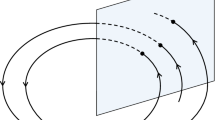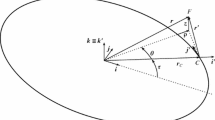Abstract
The paper presents a new semi-analytical technique for the propagation of near-Earth satellite motion. The approach uses differential algebra techniques to compute the high order expansion of the solution of the system’s ordinary differential equation for one orbital revolution, referred to as the transfer map. Once computed, a single high order transfer map (HOTM) can be reused to map an initial condition, or a set of initial conditions, forward in time for many revolutions. The only limiting factor is that the mapped objects must stay close to the reference orbit such that they remain within the region of validity of the HOTM. The performance of the method is assessed through a set of test cases in which both autonomous and non-autonomous perturbations are considered, including the case of continuously propelled trajectories.













Similar content being viewed by others
References
Aksnes, K.: A second-order artificial satellite theory based on an intermediate orbit. Astron. J. 75, 1066–1076 (1970)
Berz, M.: The new method of TPSA algebra for the description of beam dynamics to high orders. In: Technical Report AT-6:ATN-86-16, Los Alamos National Laboratory (1986)
Berz, M.: The method of power series tracking for the mathematical description of beam dynamics. Nucl. Instrum. Methods A258, 431 (1987)
Berz, M.: Differential algebraic techniques. In: Tigner, M., Chao, A. (eds.) Handbook of Accelerator Physics and Engineering. World Scientific, New York (1999a)
Berz, M.: Modern Map Methods in Particle Beam Physics. Academic Press, London (1999b)
Berz, M., Makino, K.: COSY INFINITY version 9 reference manual. In: MSU Report MSUHEP-060803, Michigan State University, East Lansing, MI 48824, pp 1–84 (2006)
Bogoliuvov, N.N., Mitropolski, Y.A.: Asymptotic Methods in the Theory of Nonlinear Oscillations. Gordon and Breach, New York (1961)
Brouwer, D.: Solution of the problem of artificial satellite theory without drag. Astron. J. 64, 379–397 (1959)
Campbell, J.A., Jeffreys, W.H.: Equivalence of the perturbation theories of Hori and Deprit. Celest. Mech. 2, 467–473 (1970)
Deprit, A.: Canonical transformations depending on a small parameter. Celest. Mech. 1, 12–30 (1969)
Graf, O.F., Bettis, D.G.: Modified multirevolution integration methods for satellite orbit computation. Celest. Mech. Dyn. Astron. 11, 433–448 (1975)
Healy, L.M.: Orbit propagation with Lie transfer maps in the perturbed Kepler problem. Celest. Mech. 85, 175–207 (2003)
Hoots, F.R., Roehrich, R.L.: Models for propagation of the NORAD element sets. In: Spacetrack Report no. 3, US Air Force Aerospace Defense Command, Colorado Springs, Col (1980)
Hori, G.: Theory of general perturbation with unspecified canonical variable. Publ. Astron. Soc. Jpn. 18, 287–296 (1966)
Kinoshita, H.: Third-order solution of an artificial satellite theory. In: Special Report No. 379, Smithsonian Astrophysical Observatory, Cambridge, Mass (1977)
Kozai, Y.: Second-order solution of artificial satellite theory without air drag. Astron. J. 67, 446–461 (1962)
Lara, M., San-Juan, J.F., López-Ochoa, L.M., Cefola, P.J.: On the third-body perturbations of high-altitude orbits. Celest. Mech. Dyn. Astron. 113, 435–452 (2012)
Long, A.C., Cappellari, J.O., Velez, C.E., Fuchs, A.J.: Goddard trajectory determination system (GTDS). Mathematical Theory Revision 1 CSC/TR-89/6001 (1989)
Lyddane, R.N.: Small eccentricities or inclinations in Brouwer theory of the artificial satellite. Astron. J. 68, 555–558 (1963)
McClain, W.D.: A recursively formulated first-order semianalytic artificial satellite theory based on the generalized method of averaging, volume 1: the generalized method of averaging applied to the artificial satellite problem. Computer Sciences Corporation CSC/TR-77/6010 (1977)
Métris, G., Exertier, P.: Semi-analytical theory of the mean orbital motion. Astron. Astrophys. 294, 278–286 (1995)
Montenbruck, O., Gill, E.: Satellite Orbits: Models, Methods, and Applications. Springer, Berlin (2000)
Morselli, A., Armellin, R., Di Lizia, P., Bernelli-Zazzera, F: A high order method for orbital conjunctions analysis: sensitivity to initial uncertainties. Adv. Space Res. 53, 490–508 (2014)
Picone, J.M., Hedin, A.E., Drob, D.P., Aikin, A.C.: NRLMSISE-00 empirical model of the atmosphere: statistical comparisons and scientific issues. J. Geophys. Res. Space Phys. 107, 1978–2012 (2002)
San-Juan, J.F.: ATESAT: automatization of theories and ephemeris in the artificial satellite problem. In: Tech. Rep. no. CT/TI/MS/MN/94-250, CNES, Toulouse, France (1994)
San-Juan, J.F.: ATESAT: review and improvements. Study of a family of analytical models of the artificial satellite generated by ATESAT and their numerical validation versus PSIMU and MSLIB. Tech. Rep. no. DGA/T/TI/MS/MN/97-258, CNES, Toulouse, France (1998)
Vallado, D.A., Crawford, P., Hujsak, R., Kelso, T.S.: Revisiting spacetrack report# 3. AIAA J. 2006–6753, 1–88 (2006)
Valli, M., Armellin, R., Di Lizia, P., Lavagna, M.: Nonlinear mapping of uncertainties in celestial mechanics. J. Guid. Control Dyn. 36, 48–63 (2013)
Walker, M.J.H., Owens, J., Ireland, B.: A set of modified equinoctial orbit elements. Celest. Mech. Dyn. Astron. 36, 409–419 (1985)
Walker, M.J.H.: Erratum—a set of modified equinoctial orbit elements. Celest. Mech. Dyn. Astron. 38, 391–392 (1986)
Wittig, A., Di Lizia P., Armellin, R., Makino, K., Bernelli-Zazzera, F., Berz, M.: Propagation of large uncertainty sets in orbital dynamics by automatic domain splitting. Celest. Mech. Dyn. Astron. (2015). doi:10.1007/s10569-015-9618-3
Acknowledgments
R. Armellin is grateful to Dr. Martín Lara for having provided a comprehensive overview of orbital propagation methods. A. Wittig gratefully acknowledges the support received by the EU Marie Curie ITN AstroNet-II (PITN-GA 2011-289240) through an experienced researcher fellowship. The authors thank Dr. Martin Berz for introducing them to Differential Algebra techniques and his fundamental work in establishing many of the concepts applied in this work in the field of beam and accelerator physics. Furthermore, we are in debt to Pierluigi Di Lizia. This work can be considered as another fruit of the many discussions we had while working together. Once he finishes drilling on 67P/Churyumov-Gerasimenko, we look forward to working with him again.
Author information
Authors and Affiliations
Corresponding author
Rights and permissions
About this article
Cite this article
Wittig, A., Armellin, R. High order transfer maps for perturbed Keplerian motion. Celest Mech Dyn Astr 122, 333–358 (2015). https://doi.org/10.1007/s10569-015-9621-8
Received:
Revised:
Accepted:
Published:
Issue Date:
DOI: https://doi.org/10.1007/s10569-015-9621-8




